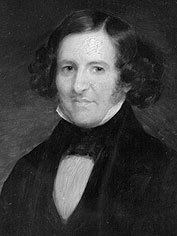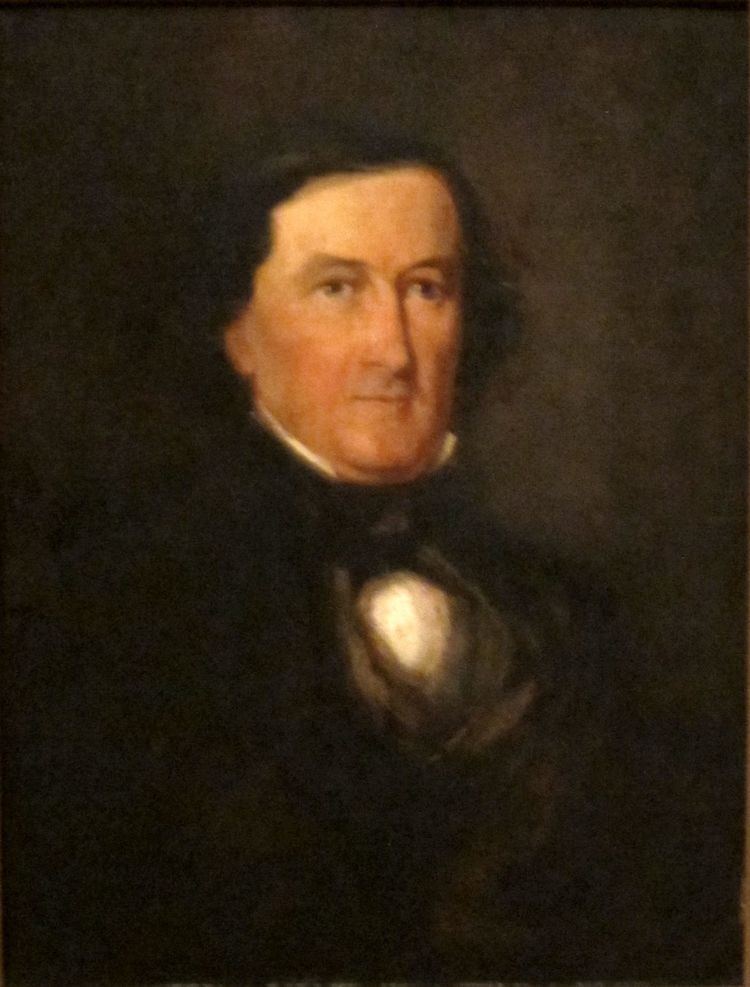Name George Whistler | Role Engineer | |
 | ||
Spouse Anna McNeill Whistler (m. 1831) Children James Abbott McNeill Whistler Parents Anna Bishop, John Whistler Similar People James Abbott McNeill, Anna McNeill Whistler, William McNeill Whistler, John Whistler | ||
George Washington Whistler (1800 –1849) was a prominent American civil engineer in the first half of the 19th century. He was a steam locomotive builder whose shop produced the first steam locomotives in the United States known to have been equipped with whistles. In 1842, he was engaged by the Russian government as a consulting engineer for the Saint Petersburg – Moscow Railway, the first large-scale implementation of railroad transportation in Russia. The railway line, as planned was 644 km long and built between 1842 and 1851. One of Whistler's important influences was the introduction of the Howe truss for the Russian railroad's bridges. This inspired the renowned Russian engineer Dmitrii Ivanovich Zhuravskii (1821–1891) to perform studies and develop structural analysis techniques for Howe truss bridges.
He was the father of James McNeill Whistler, the famous American artist.Whistler's Mother, a portrait of Anna Whistler (his second wife), by their son, James McNeill Whistler, is among the most famous paintings in American art.
Contents
- Early life and family
- Education and career
- Baltimore and Ohio railroad
- Other railroads
- Locomotive designer and builder
- Western railroad Massachusetts
- Saint Petersburg Moscow railway
- Professional associations
- Legacy
- Works
- References

Early life and family
George Washington Whistler was born on May 19, 1800 at the military outpost of Fort Wayne which his father, Major John Whistler (1756–1829) was commandant and his wife, Anna Bishop. Ft. Wayne at that time was a part of the great Northwest Territory. His father, John Whistler, had been a British soldier under General Burgoyne at the battles of Saratoga in the revolutionary war, later to enlist in American service.
George Washington Whistler married his first wife, Mary Roberdeau Swift, (1804–1827) and they had three children, George William (1822–1869), Deborah Delano (1825–1908) and Joseph Swift (1824–1840). However, Mary Roberdeau Swift died at a young age in 1827. Whistler then married the sister of his close friend William Gibbs McNeill (1801–1853), Anna Mathilda McNeill (1804–1881), with whom he had five sons: James Abbott McNeill Whistler, William McNeill Whistler (1836–1900), Kirk Boott (1838–1842) named after Kirk Boott, Charles Donald Whistler (1841–1843), and John Bouttatz Whistler (1845–1846), named after Whistler's Russian engineer friend Major Ivan F. Bouttatz.
Education and career
Whistler graduated from the United States Military Academy in 1819. Upon graduation, Whistler was commissioned a Second Lieutenant in the Corps of Artillery serving as a topography engineer at Fort Columbus, New York from 1819 to 1821. When the Army was reorganized in 1821, he became a Second Lieutenant in the First Artillery. From 1821 to 1822, Whistler was an Assistant Professor of Drawing at West Point.
Whistler was reassigned back to artillery corps duty as a topographical engineer in 1822, his first assignment was supporting the Commission tracing the international boundary between Lake Superior and Lake of the Woods. Subsequent to the passage of the General Survey Act of 1824, Whistler later conducted surveys for locating railroads working under John James Abert, the head of the Topographic Bureau.
Baltimore and Ohio railroad
In 1827, Whistler's brother in law and fellow engineer, William Gibbs McNeill became a member of the Baltimore and Ohio railroad's "Board of Civil Engineers for the Construction of the Road" (1827‑30). Whistler, still on active duty, joined the railroad's engineer corps the next year in 1828. Together, Whistler, McNeill and Jonathan Knight went to Great Britain to study railroad engineering practices in that country. They were welcomed by President Telford, of the British Institution of Civil Engineers where they also met with George Stephenson and son, John Walker, Joseph Locke, Jesse Hartley, and other eminent British engineers. They also saw the British railroad, the Stockton and Darlington, the world's first public railway to use steam locomotives. As one observer wrote:
" Apparently there was nothing to keep American engineers with adequate credentials from seeing all they wanted to see and from asking about all that they wanted to learn. As a result the American engineers developed knowledge of railroads in three areas -Whistler supervised construction of the first rails on the railroad in October 1829, consisting of wood and iron from Pratt street to the Carrollton viaduct. The railroad's future road master, Wendel Bollman as a fifteen year old carpenter, helped with the construction layout.
Other railroads
In 1830, McNeill and Whistler entered the service of the Baltimore and Susquehanna railroad, Whistler remaining on the project for the first twenty miles of main and branch track had been completed. In 1831‑32, Whistler provided engineering services for the Paterson and Hudson River railroad (now southern terminus of Erie) Railroad; and in 1833‑34, upon the Providence and Stonington Railroad. Whistler resigned his army engineer commission in December 1833.
In 1835, along with William Gibbs McNeill, Whistler designed the Boston & Providence Railroad which included the famous Canton Viaduct which has been in continuous service for 174 years.
Locomotive designer and builder
In 1834, Whistler became chief engineer at the Proprietors of Locks and Canals in the new city of Lowell, Massachusetts. With his West Point engineering education, Whistler was one of the few locomotive designers and builders in the early 19th century that had an academic education. As superintendent of the Proprietors of Locks and Canals Co. water powered machine shop in Lowell (1834–1837), Whistler was responsible for the design of the earliest steam locomotive built in New England. In 1835, he worked with Patrick Tracy Jackson to begin the Boston & Lowell Railroad.
Whistler's first locomotive, the Patrick, was produced for the Boston & Lowell Railroad. This locomotive and others built by the firm were initially copies of Stephenson Planet types (2-2-0s). In 1836, the first two steam locomotives known to have been equipped with whistles were built by Whistler as 2-2-0 types; the Hicksville for the Long Island Railroad and the Susquehanna for the Wilmington & Susquehanna Railroad. In 1838, Baltimore and Ohio railroad engineers Knight and Latrobe surveyed steam locomotives for their management, some of which included machines built in Whistler's Lowell shops.
The (Long Island railroad) engine burns one cord of wood in each circular trip of 48 miles, conveying an average load of twenty tons of freight, in four cars, each weighing two tons - the weight of engine being 8.5 tons, with its fuel and water in the boiler, and having six tons on the two driving wheels; the tender weighs 4.5 tons with fuel and water, the additional quantity of wood consumed in getting up steam, being about one-fifth of a cord.
Whistler built three machines for the Boston and Providence Rail Road, they were almost 9 tons in gross weight and 6 tons in weight on the five foot driving wheels, a 2-4-0 configuration. These machines had 11 inch cylinders with a 16 inch stroke. Whistler also built one locomotive for the New Jersey and Patterson Rail Road weighing 8 tons gross.
Whistler left Lowell in 1837 and was followed by his apprentice, James B Francis. The Lowell Machine Shop's locomotive production continued until 1854.
Western railroad (Massachusetts)
Soon after Whistler's work on the Stonington Railroad he was engaged to consult on the Western railroad again with McNeill from 1836 to 1842. In October, 1839, the road's Board of Directors hired Whistler as its Chief engineer.
The main problem in locating the railroad were the steep grades west of the Westfield River, a major tributary of the Connecticut River, which were in excess of 80 feet to the mile, (actually 1.65%. west of Chester, Massachusetts). At that time in 1842, there was no known locomotive that could deliver the tractive effort to climb that grade. The first locomotives purchased for the road in 1842 were Ross Winan's "crabs" or 0-8-0s which could not handle the grade. Whistler substituted Stephenson Planet types (2-2-0s) which delivered satisfactory service.
Saint Petersburg – Moscow railway
The Tsarskoye Selo Railway was the first public railway line in the Russian Empire, built by de:Franz Anton Ritter von Gerstner in 1837. The railway had length of 27 km (17 mi) with a track gauge of 6 ft (1,829 mm). However, given the cost overruns on the Tsarskoye Selo Railway, ..."Tsar Nicholas I and his advisors were not convinced that Gerstner's road was a realistic model for the planned St. Petersburg–Moscow line."
Two professors from the Institute of the Corps of Transportation Engineers in St. Petersburg, Pavel Petrovich Melnikov (1804–1880) and Nikolai Osipovich Kraft (1798–1857) left home on June 1, 1839, for an inspection trip to America to America to study railroad technology. Melnikov and Kraft spoke with Whistler as part of their trip. One of their recommendations to the Russian government was to retain Whistler as a consulting engineer on the Saint Petersburg – Moscow Railway project. The recommendation was accepted and Whistler was given a seven-year contract.
Whistler left for Russia in June, 1842, accompanied by imperial engineer Major Ivan F. Bouttatz who would become Whistler's friend in Russia. A bridge model of similar design to the Canton Viaduct at the October Railroad Museum in St. Petersburg In 1842, Whistler was employed by engineer Pavel Petrovich Melnikov as a consultant on the building of Russia's first major railroad, the Moscow-Saint Petersburg Railway. While working on this project, he contracted cholera and died on April 7, 1849 in Saint Petersburg, Russia two years before the line was completed. He is credited with selecting the five-foot rail gauge still used in Russia and neighboring countries.
Professional associations
Whistler was part of the first efforts to form a national engineering association in the United States, although unsuccessful, it was thirteen years ahead of the American Society of Civil Engineers and Architects formed in 1852. There was an organizational meeting in Baltimore, Maryland in 1839 that elected Benjamin Latrobe as its president. The organizing committee included some of the most prominent and representative engineers of the day such as: J. B. Jervis and Benjamin Wright of New York, Moncure Robinson and Claude Crozet of Virginia, Jonathan Knight of Maryland, J. Edgar Thomson then in Georgia, later in Pennsylvania.
Legacy
Stone arch railroad bridges built by George Washington Whistler in 1841 are still in freight and passenger service on the CSX mainline in western Massachusetts.
He was the first civil engineer in America to use contour lines to show elevation and relief on maps.
